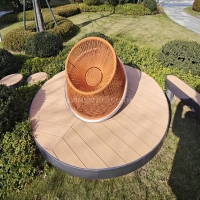Welcome to the website for landscape facilities products and knowledge.
What are the key differences between metal, wood, and plastic landscape chairs in terms of longevity?
When choosing landscape chairs for outdoor spaces, longevity is a critical factor. Metal, wood, and plastic each offer distinct advantages and drawbacks in terms of durability.
Metal Landscape Chairs
Metal chairs, typically made from aluminum, steel, or wrought iron, are highly durable and resistant to weathering. Aluminum is rust-proof and lightweight, while powder-coated steel offers added protection against corrosion. Wrought iron, though heavy, can last decades with proper maintenance. However, metal can become uncomfortably hot in direct sunlight and may dent or scratch over time.
Wood Landscape Chairs
Wooden chairs, especially those made from teak, cedar, or eucalyptus, are naturally resistant to rot and insects. Teak is particularly long-lasting due to its high oil content. However, wood requires regular sealing or staining to prevent weathering, and untreated wood can warp or crack. With proper care, wood chairs can last 10-20 years, but neglect shortens their lifespan significantly.
Plastic Landscape Chairs
Plastic chairs, often made from polypropylene or recycled materials, are lightweight and resistant to moisture, making them ideal for damp climates. High-quality UV-resistant plastic can last 5-10 years without fading or cracking. However, cheap plastic becomes brittle over time and is prone to breaking under heavy use.
Conclusion
For maximum longevity, metal (especially aluminum or powder-coated steel) is the best choice, followed by high-quality wood with maintenance. Plastic offers decent durability at a lower cost but may not last as long as metal or well-maintained wood. Consider your climate, budget, and maintenance willingness when selecting the best material for your outdoor chairs.
Related search:

Recommendation
Swivel chair-Specialty steel structure woven rattan leisure chair with rotatable design